Waterproofing protects the materials of the roofing system from water ingress. Moisture penetrates as a result of rain or melting snow on the roof surface. Roof waterproofing ensures efficient operation of the house and increases the durability of the covering decking. Installation technology and the choice of material depend on the roof structure, conditions of use.
Rules for the selection of waterproofing materials
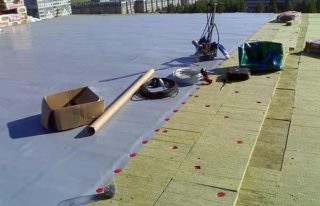
Roofing materials often provide complete protection against wetting, therefore, the device of an additional waterproofing membrane aims to limit the loss of condensation on the supporting structures and insulation. The protective layer from the cold ceases to function when wet.
You need to choose roof waterproofing taking into account:
- Fastening method. The mechanical method is used, spraying, sticker, fusion. The bottom and top material of construction are taken into account. For example, it is impossible to overlay on foam plastic, because it will collapse.
- Steam permeability. Sometimes a complex system with an air gap is successfully replaced with a superdiffuse film.
- Heat resistance. Waterproofing must be resistant to increased thermal conditions.
Choose waterproofing, which is repaired if necessary. For roofs with a slope of less than 15 °, seamless options are set, and roll materials are mounted with an overlap using technology.
Roof waterproofing device
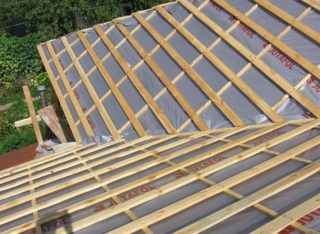
Roof waterproofing must be installed in insulated roof decks. An exception is allowed for roofs where an accurate heat engineering calculation is made, providing for a dew point shift into a hydrophobic layer.
The complex of works includes:
- surface preparation;
- laying a waterproofing layer with a fence;
- sealing and processing of butt seams.
For large areas, a material is used that can be laid by a mechanized method to speed up work. For cold roofs, waterproofing is usually not used. Condensation from a change in daily temperature can be neglected while ensuring ventilation and proper installation of other structures and coatings.
The membrane is installed when installing a flooring made of metal tiles, folded sheets and slate to prevent water leakage. If you use bulk insulation from natural components, the waterproofing film protects it from gradual weathering.
The main types of waterproofing
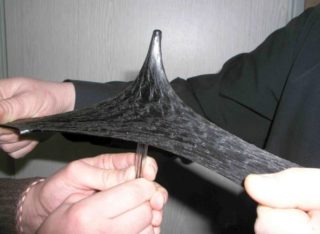
For a specific coating, waterproofing materials for the roof are used, which are recommended by the manufacturer. For example, a branded lining is mounted under the roll tiles and third-party materials are not allowed.
Varieties are used:
- membranes and roll types, for example, PVC films;
- metal flat sheets or plastic;
- liquid materials such as spray cork or liquid rubber;
- protection based on mineral binders;
- layers based on bentonite clays;
- penetrating mixtures in the form of soluble dry formulations.
The type of material depends on the type of roof deck. For example, on corrugated board or metal tiles, fasteners loosen over time and the gaskets do not seal.Roofing and waterproofing materials are installed that can withstand the volume of incoming water. In this case, PVC films with a fabric backing and diffuse barriers are used.
Glass insulation or roofing material is placed under bituminous flooring and slate, which are not very durable. Moisture penetrates into the damaged areas more than through the fastening points, therefore, several layers are used to preserve the integrity of the waterproofing until the current repair.
Roll materials
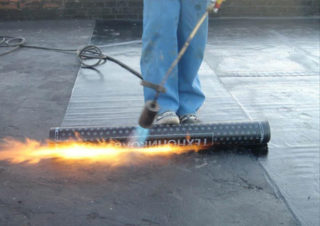
The glued waterproofing for the roof is made using a multi-layer coating of roofing material, windproof hydrophobic material, and a waterproof film. The surface is protected with walls and screeds. Such decks from moisture are characterized by increased formation of cracks and improvement is directed towards the use of polymer membranes and fiberglass cloth.
Rolls are rolled vertically on steep slopes (more than 40 °) and placed across on flat roofs. The peculiarity of the installation lies in the high-quality processing of overlaps. One edge of the laid roofing material is heated until bituminous drops appear, then the edge of the adjacent strip is applied to it so that the approach is 15 - 20 cm, depending on the steepness of the roof.
Polymer film insulation is laid on glue. Most materials of this type are processed before installation to enhance adhesion to the base. Solvents are used trichlorethylene, toluol and slightly warmed up the surface with a hairdryer.
Liquid substances
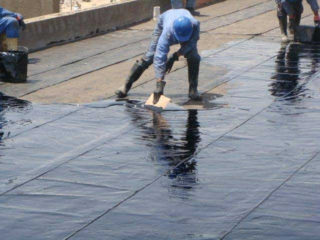
Cast layers are a reliable type of moisture insulation; they are made from heated bituminous mastics and solutions. Materials are poured on a horizontal basis, 2 - 3 layers with a thickness of 20 - 25 mm are made, they are brought onto the walls of the parapet 30 - 50 cm in height. Replaced with bitumen perlite, asphalt expanded clay concrete, polystyrene, foam epoxy compositions. Filling a flat roof with liquid rubber is done over a solid surface.
There are types of liquid insulation:
- bitumen-based mastics that harden in atmospheric conditions;
- molten bitumen and resins;
- PVC materials.
In the first two options, the materials are applied to a dust-free area, using penetrating primers. Mastics, bitumen, roofing rubber are used on small slopes and when constructing inverted roofs (when the insulation is placed on top of the waterproofing). Fiberglass and roofing paper are used for reinforcement.
Polyurea products provide reliable protection against water, their service life is 20 - 30 years. Spraying is not done on their own, since special equipment and knowledge of technology are required.
Sheet materials
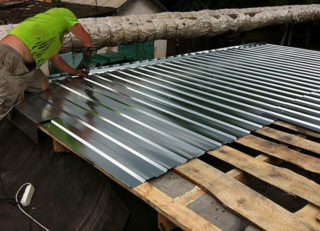
Piece insulation is installed using metal, plastic plates, profile sheets. They are mounted to the base and used infrequently. Structural insulating materials are used in combination with sealing expansion gaps and structural joints. A piece roof waterproofing ensures the continuity of the overall roof covering.
Types of sheet insulation:
- Steel sheets are mounted by welding joints. The material belongs to a durable and reliable layer. The surface of the insulating deck is coated with anticorrosive agents and covered with roofing paints.
- Plastic is an inexpensive option, but its strength is reduced compared to metal. The sheets are glued to the surface, the joints are connected after heating with a hot air stream. The seams are coated with a moisture-repellent agent, the area of the sheets is painted.
Sheet waterproofing is better for the roof if the surface is exposed to mechanical stress (exploited roofs), and there is a danger of breaking the integrity.
Membrane films
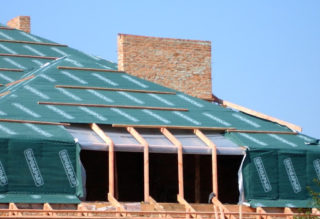
Diffusion films are rolled materials that conduct moisture in one direction and remove vapor from the insulation. Such waterproofing ventilates the protective layer from the cold and prevents condensation.
The membranes are mounted so that their outer surface is in the ventilated gap and they organize the movement of flows from the eaves to the ridge. The film for the roof under the metal tile is placed in front of the counter-lattice in order to maximize the conditions for trouble-free operation.
Super diffusion insulators do not require a ventilated gap, as they absorb and accumulate some moisture due to their highly porous structure. Subsequently, they gradually release water, even with limited ventilation. For their functioning, there are enough gaps from the wave corrugated board, but when arranging the ridge, aerators are mounted. Roll the membranes up, starting from the eaves.
Step-by-step installation instructions
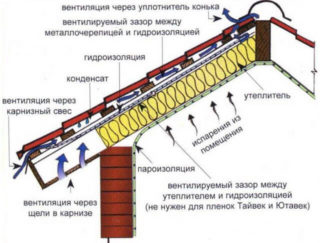
Waterproofing is installed simultaneously with the fastening of the main and additional battens (counter battens). A double layer of lath is more difficult to make, but the technology ensures long-term operation without problems.
Stages of installation of film insulation:
- stuffing the lathing on a layer of insulation;
- rolling a roll of insula lengthwise, upward with a smooth surface;
- fastening with a stapler to one side, fixing the remaining edges with a stretch;
- trimming overhanging protrusions, processing joints;
- installation of a counter-lattice;
- roof installation.
The edges of the membranes or films are offset by 0.5 meters when laying several layers of insulation. Instead of a stapler, you can use nails with large heads. Roofing material, roofing felt and glassine are laid at a temperature of at least + 10 ° C. Spraying of liquid insulators is carried out in strips 1 - 1.5 meters wide.
In places of complex configuration, film waterproofing is glued to the surface.
Roof waterproofing repair
The roofing is dismantled for repair. On flat roofs, three-layer insulation with roofing felt is sometimes the coating itself, so dismantling is not performed. Repair of cracks in roofing material or bitumen coating is done with molten bitumen or liquid rubber. Materials adhere firmly to old layers and fill gaps.
Film coatings are repaired with patches of a similar material. Docking points are cleaned of dust. If access to the damaged area is difficult, cut off a piece of lathing, substituting solid material under it so as not to damage the whole insulation.
The size of the patch is taken 5 - 7 cm larger on all sides, usually a piece of 15 x 15 or 20 x 20 cm is enough. Special glue is used for gluing, it is convenient to mount the elements on double-sided tape along the contour of the patch. The removed rail is nailed.








